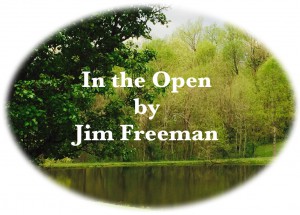Many ways of looking at stream health

July 3, 2016
 Working at a soil and water conservation district, with all of the other activity going on, it can be pretty easy to forget that our focus is primarily on the soil and water resources of our county. So in this column I am going to talk about one of our basic water resources: streams and creeks.
Working at a soil and water conservation district, with all of the other activity going on, it can be pretty easy to forget that our focus is primarily on the soil and water resources of our county. So in this column I am going to talk about one of our basic water resources: streams and creeks.
There are several methods researchers use to determine the health of a stream, and none of them give the complete picture, so you have to use a variety of methods to gauge the overall health of a stream. In short you aren’t only looking at water quality, but also the land alongside the stream, the habitat, and what actually lives in the stream.
What does the creek look like? Does it have shaded banks, sinuous curves and bends, pools, runs and riffles, is the creek bottom all silted in, or does it run free over gravel and cobble. All of this information is used to assess stream health. A creek that is straight and channelized, full of sediment, with no shade or structure isn’t going to score well in this category.
Of course appearances can be deceiving; a creek can look healthy from a distance but still suffer from poor water quality. Here in southeastern Ohio streams are often impacted with nutrients from failing septic systems, or from farm animals and fertilizers, silt and sediment from agricultural fields or logging, or sediment and acid mine drainage (AMD) from abandoned coal mines. Creeks in urban areas have their own unique concerns. The only way to tell for sure is to take samples of water and send it off to a lab. Nutrients (fertilizers, septic and manure), metals, acidity and more can be determined from water samples.
Once you understand the stream’s habitat and water quality, it is time to look at what actually lives in the creek. Some aquatic animals can tolerate pollution rather well, those are called tolerant species, other species are very intolerant of pollution and are called intolerant species. So if you have a stream chock full of intolerant species, chances are you have a decent-quality stream; likewise, a stream with mostly tolerant species, or nothing at all, indicates that there are some issues.
Just like you can tell a lot about a stream by the type and number of fish that live in it, you can tell a lot by the type and number of bugs that live in it as well. A plentitude of non-tolerant aquatic bugs may signify a healthy or recovering stream, while a stream consisting of pollution-tolerant bugs, or even worse, no bugs, can indicate a poor or degrading stream.
With all else being equal, looking at the fish and bugs in a stream is a good way to determine if water quality is getting better or worse.
In Meigs County, the Meigs SWCD works closely with the Ohio Department and Natural Resources and other agencies to monitor the health of Thomas Fork, which is an AMD-impacted tributary stream of Leading Creek In Thomas Fork we usually do the macroinvertebrate (bug) sampling in July.
I’m pretty sure I have said this before, but conservation isn’t pretty – it’s not even cute. It’s not all about saving bald eagles or baby seals. I am reminded of that when I am sitting there on the bank or on a gravel bar, poring through pebbles and sand with a pair of tweezers plucking out the bugs and sticking them in a specimen jar to be identified and counted later. Those bugs are taking one for the team in the name of science.
The annual fish assessment is held later in the year, and it involves wading the streams and using a netted electric wand to zap fish to the surface so they can be identified and counted. Unlike the bugs, the fish get released (I consider it the fish equivalent of an alien abduction and imagine the fish telling other, unbelieving fish about the experience).
In short, all of these different ways of monitoring help researchers determine the health of the stream and give it one of designations: Exceptional Warmwater Habitat, Warmwater Habitat, Modified Warmwater Habitat, and Limited Resource Water. Ideally all streams would attain Warmwater Habitat, with Exceptional Warmwater Habitat streams meriting the most protection and Limited Resource Waters lacking the potential for any aquatic life habitat.
Jim Freeman is the wildlife specialist for the Meigs Soil and Water Conservation District. He can be contacted weekdays at 740-992-4282 or at [email protected]








